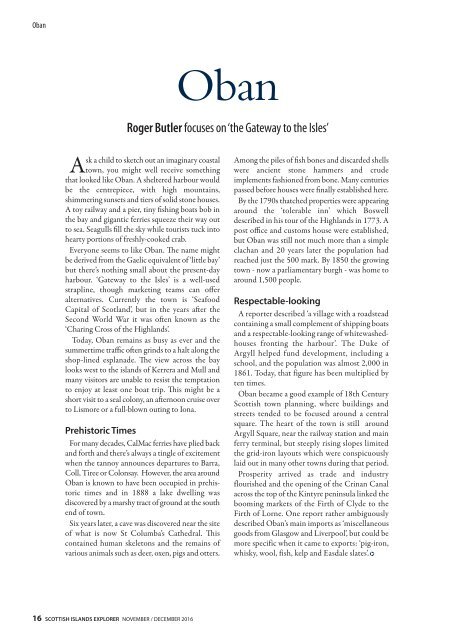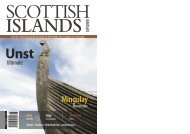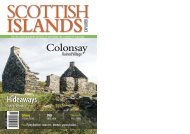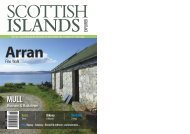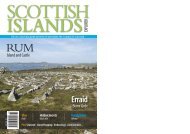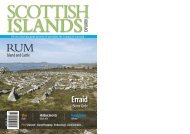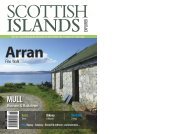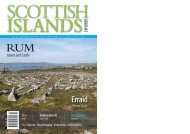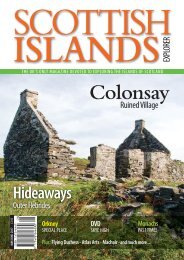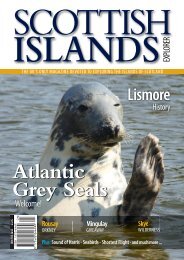You also want an ePaper? Increase the reach of your titles
YUMPU automatically turns print PDFs into web optimized ePapers that Google loves.
Oban<br />
Oban<br />
Roger Butler focuses on ‘the Gateway to the Isles’<br />
Ask a child to sketch out an imaginary coastal<br />
town, you might well receive something<br />
that looked like Oban. A sheltered harbour would<br />
be the centrepiece, with high mountains,<br />
shimmering sunsets and tiers of solid stone houses.<br />
A toy railway and a pier, tiny fishing boats bob in<br />
the bay and gigantic ferries squeeze their way out<br />
to sea. Seagulls fill the sky while tourists tuck into<br />
hearty portions of freshly-cooked crab.<br />
Everyone seems to like Oban. e name might<br />
be derived from the Gaelic equivalent of ‘little bay’<br />
but there’s nothing small about the present-day<br />
harbour. ‘Gateway to the Isles’ is a well-used<br />
strapline, though marketing teams can offer<br />
alternatives. Currently the town is ‘Seafood<br />
Capital of Scotland’, but in the years aer the<br />
Second World War it was oen known as the<br />
‘Charing Cross of the Highlands’.<br />
Today, Oban remains as busy as ever and the<br />
summertime traffic oen grinds to a halt along the<br />
shop-lined esplanade. e view across the bay<br />
looks west to the islands of Kerrera and Mull and<br />
many visitors are unable to resist the temptation<br />
to enjoy at least one boat trip. is might be a<br />
short visit to a seal colony, an aernoon cruise over<br />
to Lismore or a full-blown outing to Iona.<br />
Prehistoric Times<br />
For many decades, CalMac ferries have plied back<br />
and forth and there’s always a tingle of excitement<br />
when the tannoy announces departures to Barra,<br />
Coll, Tiree or Colonsay. However, the area around<br />
Oban is known to have been occupied in prehistoric<br />
times and in 1888 a lake dwelling was<br />
discovered by a marshy tract of ground at the south<br />
end of town.<br />
Six years later, a cave was discovered near the site<br />
of what is now St Columba’s Cathedral. is<br />
contained human skeletons and the remains of<br />
various animals such as deer, oxen, pigs and otters.<br />
Among the piles of fish bones and discarded shells<br />
were ancient stone hammers and crude<br />
implements fashioned from bone. Many centuries<br />
passed before houses were finally established here.<br />
By the 1790s thatched properties were appearing<br />
around the ‘tolerable inn’ which Boswell<br />
described in his tour of the Highlands in 1773. A<br />
post office and customs house were established,<br />
but Oban was still not much more than a simple<br />
clachan and 20 years later the population had<br />
reached just the 500 mark. By 1850 the growing<br />
town - now a parliamentary burgh - was home to<br />
around 1,500 people.<br />
Respectable-looking<br />
A reporter described ‘a village with a roadstead<br />
containing a small complement of shipping boats<br />
and a respectable-looking range of whitewashedhouses<br />
fronting the harbour’. The Duke of<br />
Argyll helped fund development, including a<br />
school, and the population was almost 2,000 in<br />
1861. Today, that figure has been multiplied by<br />
ten times.<br />
Oban became a good example of 18th Century<br />
<strong>Scottish</strong> town planning, where buildings and<br />
streets tended to be focused around a central<br />
square. The heart of the town is still around<br />
Argyll Square, near the railway station and main<br />
ferry terminal, but steeply rising slopes limited<br />
the grid-iron layouts which were conspicuously<br />
laid out in many other towns during that period.<br />
Prosperity arrived as trade and industry<br />
flourished and the opening of the Crinan Canal<br />
across the top of the Kintyre peninsula linked the<br />
booming markets of the Firth of Clyde to the<br />
Firth of Lorne. One report rather ambiguously<br />
described Oban’s main imports as ‘miscellaneous<br />
goods from Glasgow and Liverpool’, but could be<br />
more specific when it came to exports: ‘pig-iron,<br />
whisky, wool, fish, kelp and Easdale slates’.<br />
16 SCOTTISH ISLANDS EXPLORER NOVEMBER / DECEMBER <strong>2016</strong>


